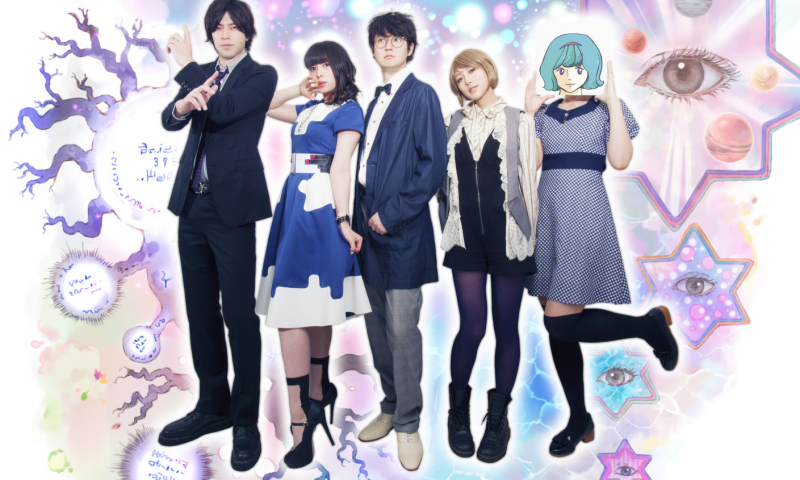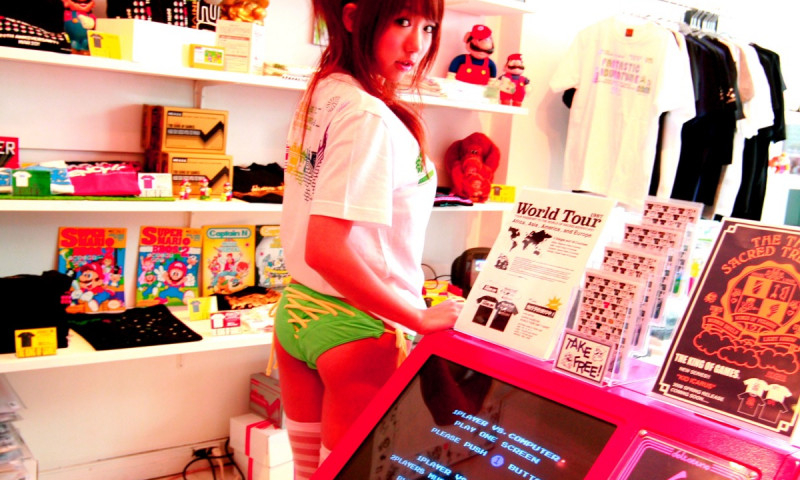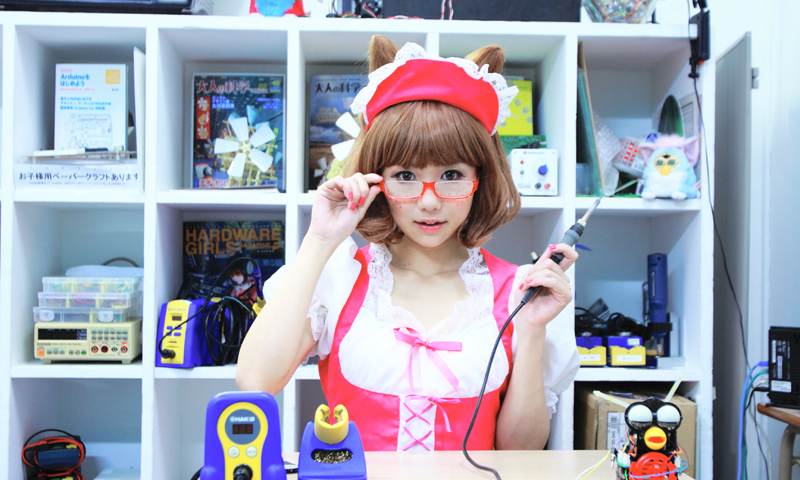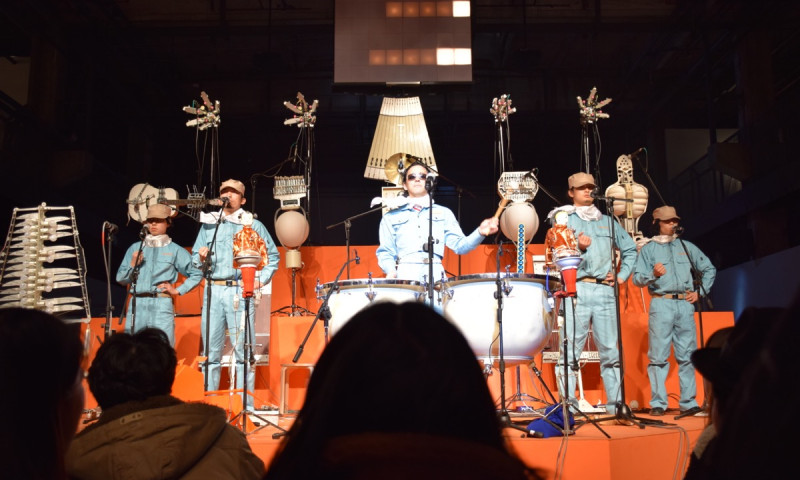
TOKYO CUTTING EDGE CREATORS by Julie Watai #11 featuring Frenesi: The Singer-Songwriting-Animator

When you open any SNS, you can easily find many people uploading daily snapshots of themselves with their smartphones or iPhones. Selfies have now become a part of younger Japanese culture. Numerous gadgets are currently being developed as an update to this selfie culture. One of these is the Sel*Kira selfie light. The person behind it is Julie Watai, a photographer and creator whose name became well known throughout the world after the publication of her Italian-published photo book, Samurai Girl. Her latest invention, Sel*Kira, is said to be the “ultimate selfie weapon”. We turned to her to Watai, who has continued to integrate Japanese otaku culture in her works, about what kind of item Sel*Kira is, and her views on Japanese selfie culture.
SNSを開くと、そこにはスマートフォンやiPhoneで撮った自分の画像を毎日のようにアップしている人たちが大勢いる。いまや自撮りはすっかり日本の若者の文化のひとつとなっているのだ。そんな自撮り文化をさらにアップデートするガジェットが現在開発されている。自撮り専用ライトのセル*キラ。開発者は、2006年に写真集『Samurai Girl』をイタリアで刊行し全世界にその名をとどろかせた、写真家でクリエイターのJulie Wataiだ。彼女は、今回開発しているセル*キラを、「自撮りの最終兵器」と呼ぶ。これまで一貫して日本のオタク文化を写真のなかで表現し続けてきた彼女に、セル*キラとは一体どんなアイテムなのか、そして日本の自撮り文化をどう見てきたのかを聞くーー。
オタク文化を外と内の眼差しで見つめてきたJulie Watai
-Before I ask you about Sel*Kira, which you developed, first I’d like to ask you about the history of your work. Samurai Girl is your masterpiece, isn’t it? After the photo book was published in Italy in 2008, it became an internationally discussed topic. Please tell is more about the circumstances that led up to this work.
今回、Julieさんの発明されたセル*キラのお話をお聞きする前に、これまでの活動の軌跡についてうかがいたいなと思います。Julieさんの代表作と言えば『Samurai Girl』ですよね。この写真集は2006年にイタリアで出版され、世界的に話題になりました。この作品に至るまでの経緯をお聞かせください。
Julie:Originally I had vague notion of becoming a manga artist. I made my own doujinshi (fan-made comics) and sold them at exhibitions. But no matter how I looked at it, it seemed like it would be difficult to make money off of it. So I thought that I needed to find something else, so for a short period from the end of my teens and into my 20s I was an idol. Kind of like the concert idols now. All through that period, I took photographs as a hobby. I used the female cosplayers at that time as a single reference. Since then, I’ve always thought of photography as a way to explore self-expression. In the end I quickly quit the idol business, and continued with photography. Samurai Girl became one of the offshoots from that.
もともと私、漫画家になりたいって漠然と思ってたんですね。それで同人誌とか作って即売会とかで売ってました。でも、どれだけ収益につながるのかって考えるとちょっと難しいなって思うようになって。それで別の道を探さなければと思って、10代の終わりから20代の前半にかけての短い時間だったんですけど、アイドル活動をしていたんです。今で言うところのライブアイドルみたいなものでしたね。それと並行して、写真は趣味でずっと撮っていて。当時はコスプレイヤーの女の子を一眼レフで撮ってたりしてました。その時から、ずっと写真という手段で自分の表現を突き詰めるってことを考えていたんです。結局そのアイドルの仕事はすぐにやめちゃったんですけど、写真の方は続けていて。それが一つの形になったのが『Samurai Girl』ですね。
-While you were making Samurai Girl, you lived in Italy for about two years, is that correct? Why Italy?
『Samurai Girl』を作る時には、イタリアに2年間くらい滞在されていたんですよね。どうしてイタリアだったんですか?
Julie:During that time I was showing my photos to a lot of people. And among those people, they caught the eye of an Italian magazine editor. The editor liked the works of Takashi Murakami and so on, which have now spread through otaku culture, and because of that he said it would be good idea for me to try making a photo book. There wasn’t really any representation of otaku culture in photography then, and so I thought about trying to do it myself. Just around the time I arrived in Italy in 2003, people had just started using the phrase “Cool Japan”. However, at that time otaku culture wasn’t considered cool at all. So I wasn’t sure how to go about making the book. To try and find out, I decided to go overseas once to see how people overseas viewed Japan, and went to Italy. I took pictures there while working for a publishing company related to hobbies.
当時、写真をいろんな人に見せてたんですよ。そのなかで、イタリア人の雑誌編集者の方の目にとまったんです。その方が、今、オタク文化が世界に広まってきてて、村上隆さんとかの作品も好まれているから、これで一冊写真集を作ったら良いんじゃないかなって言ってくれて。写真でオタク文化を表現するっていうのはそれまでなかったので、これでやってみましょうってことで。ちょうど私がイタリアに来たばかりの2003年にクールジャパンっていうのが言われ始めたんですね。ただ、その頃って、オタク文化ってクールとか全くそういう時代じゃなかったんです。だから、それを作品にするってどうすれば良いかわからなくて。それを知るためにも、一回、海外に住んで日本がどう見られてるか知ってみようと思って、それでイタリアへ。そこではホビー系の出版社で働きながら写真を撮ってましたね。
-In 2010 you published a second photo book called Hardware Girls. Opposite from Samural Girl, it seems to deal with the concept of representing the fascinating-like things to do with Japanese electronic engineering from your own personal perspective. It was a completely different type of work. In Samurai Girls you were able to clearly capture the concept of how foreigners viewed Japan.
2010年には『はーどうぇあ・がーるず』という第2作目の写真集が出版されます。『Samurai Girl』とは逆に、これはJulieさんの目から見た国内の電子工学的な萌えみたいなものを表現するような形でできたと思うんですね。やっぱりタイプとしては違うと思うんですよ。『Samurai Girl』ははっきり外国の方が見てる日本を形にするっていうコンセプトがあって。
Julie:That’s right. Samurai Girl had this feeling of traveling to Japan. I think it really has the condensed feeling of that essence, which is amazing. On the other hand, Hardware Girls was like taking a step forward. The meaning behind what’s reflected in Samurai Girl is a creative Japan. But, I was glad that people were really happy about it and it made them actually want to come to Japan. When I released Hardware Girls a little later, the world’s otaku were already completely immersed in otaku culture. Therefore, the world was in a place where it was a little easier to delve deeper into things and reflect that. Since way back, I’ve been into the SF aspect of fighting pretty girls. I’ve always wanted to capture the moe (blossoming) of a girl riding and fighting on a machine. That was the theme behind making Hardware Girls and Kikai to Shoujo Moe, which were enjoyed by many.
そうですね。『Samurai Girl』は日本に旅行に来た気分になってほしくて。そのエッセンスを凝縮した感じがすごいでてるんですよ。それに対して、『はーどうぇあ・がーるず』っていうのはもうちょっと一歩進んでますよね。『Samurai Girl』に写っているのはある意味で創作の日本なんです。でも、本当に日本に来たみたいって喜んでもらって嬉しかったんですよ。それからしばらくたって、『はーどうぇあ・がーるず』を出した頃にはすっかりオタク文化っていうのが世界のオタクたちの間で浸透してて。だから、もう少し突き詰めたものが表現できる世の中になっていたんです。私、昔から戦闘美少女モノのSFが好きだったんです。機械に乗って戦ってる女の子のあの萌えを形にしたいなって思ってて。そういう想いがあったので、『はーどうぇあ・がーるず』はいろんな人に楽しんでもらえる「機械と女子萌え」っていうテーマで作りましたね。
-Recently the phrase “2.5 dimensional” has come out in Japan. Simply put, it’s a word used to describe characters that aren’t two-dimensional nor three dimensional, but are two-dimensional characters made to be three dimensional-like. Listening to you speak on the subject, I think you are probably one of the original pioneers of this.
最近、日本では2.5次元って言葉がでてきてて。要するに、ただの2次元でもなければ3次元でもない、2次元のものを3次元にしたキャラクターの表現ですね。Julieさんがやってきたことってその先駆けなんだなって今のお話を聞いてて思いました。
Julie:I appreciate the compliment. I think you may be right. I’ve always thought the two-dimensional aspect of manga was great. So much so that from a young age I thought it wasn’t believable if it wasn’t two-dimensional. That it’s no good if it’s three-dimensional. (laugh) Because of that, I went through a lot of trial and error to try to get my photos to look as two-dimensional as possible. Even from when I was originally taking pictures of cosplayers. It’s always been the root of my ideas.
ありがとうございます。そうなんですよ。私、漫画の2次元が良いってずっと思っていて。特に若い時なんか、もう2次元じゃないとありえないくらいで。3次元じゃいけない、みたいな(笑)。それで、なんとか写真を2次元に近づけるってことを試行錯誤してきました。もともとコスプレイヤーを撮ってたっていうのもあるんですけど。そういう考え方が私の根本としてずっとありましたね。
「自撮りの最終兵器」セル*キラとはいったい!?
-Now you are currently developing the selfie light Sel*Kira. You’ve already settled on what it will look like, and now you’re just relying on donations from crowdfunding. First I’d like to ask you about what made you want to create the Sel*Kira.
さて、Julieさんは今、自撮り専用ライトのセル*キラを開発されています。これはもう形になっていて、あとはクラウドファンディングで資金を集めるだけというところまできました。まず、なんでJulieさんが今回、セル*キラを作ろうと思ったのかをお聞かせいただきたいなと思って。
Julie:I often take selfies on my phone. Lately I take them with the camera on my iPhone. However, comparing the iPhone’s camera with a separate camera, the pixel count isn’t as smooth, and if the space doesn’t have much light, the picture doesn’t come out very clean. Even trying to clean up these pictures with an image editing application, they didn’t really come out any better. So I thought it would be better if at least my face was lit-up, and wanted some kind of light. There are some external lights on the market, but not any that fit what I wanted. I wondered why not. While I was thinking about that, I became a regular on the Nico live broadcast program Kuraudo! (Crowd!) Funding! When the time the show launched, I was asked, “Is there anything that you would like to do or create with the help of crowd funding?” and so I talked about my selfie light and people got excited about it. From there, it quickly began to take shape. Actually, I’m still trying to get support from crowd funding to start mass production of it. I was surprised at how much attention it received; it’s much more than I imagined.
私もよく携帯で自撮りをすることが多いんです。最近だとiPhoneのインカメラで撮るんですよ。でも、インカメラって、画素数がアウトカメラに比べて粗いので、光がいっぱいあるような場所じゃないとかなり粗く写っちゃうんですね。そうやって粗く写った写真を、画像加工アプリで綺麗にしたとしても、あまり良くならないんですよ。光がたくさんある環境で、良い解像度で撮ってないと、いくら加工してもぜんぜん良くならないっていうジレンマがあって。それで、顔だけ照らせるくらいでいいから、光がほしいって思っていたんです。外付けのライトみたいなのも売ってるんですけど、いまいちしっくりくるのがなくて。なんで無いんだろうって。そんなことを考えていた時に、「喰らうど!ファンディング!」っていうニコ生の番組にレギュラー出演させてもらうことになったんです。「番組の打ち上げの時に、「クラウドファンディングを使って、やりたい事や作りたいものある?」って聞かれたので、自撮りライトの話をしたら、皆さんが乗り気になってくださって。そこから、トントン拍子で形になっていったんです。現在、クラウドファンディングで量産するための支援を募っているところなんですけど。思ったよりも反響をいただいて驚いています。
-So when you reach your crowd funding goal, you’ll mass produce it and sell it to the general public?
クラウドファンディングが成功したら、量産して一般の人に販売したりするんですか?
Julie:That’s the plan. I want to be able to sell it in stores, though. I think there are definitely people who would want to use it. It’s even got a lot of response from people abroad, and I’ve often been asked if I plan to sell it overseas as well, especially from Asia. I think it’s because selfies are so popular. And of course, you can use it with a selfie stick without any problems. I’d love for many people to use it.
そうですね。成功したら、店頭とかで販売できるようになりたいなって思うんですけど。絶対使いたい人がいると思うので。海外の方からの反響もすごくて、これを海外で売らないのかってよく聞かれます。特にアジアの方が多いんですよ。自撮りが流行ってるんですよね。もちろん、自撮り棒をつけながらでもぜんぜん問題なく使えるので。いろんな人に使ってもらいたいですね。
-I read on Twitter that it’s actually being manufactured by a company called TASKO, and that it’s assembled at the factory by hand.
実際に製作されているTASKOという会社のTwitterを見てると、工場でハンドメイドな感じで作ってるのがわかりますね。
Julie:That’s correct. It really is a factory. It’s really amazing there. TASKO was really helpful when I coming up with the design for Cell*Kira. When I told them I wanted a design that wouldn’t interfere with cellphones while on and something that was magically compact, they were able to come up with a design just as I had described. It’s small enough to fit in the hands of women.
そうそう。めっちゃ工場ですよ。あそこ。すごいですよね。TASKOさんはセル*キラの構想を練る時にすごい考えてくださったんですよ。女性が携帯でつけて違和感がないデザインにしようっていうことで、魔法のコンパクトみたいな形がいいなっていう話をしたら、本当にそういう形にしてくれて。女性の手になじむくらいの大きさになってますよね。
-It’s amazing that it’s not just a light, but developed as a ring light, too.
ただのライトじゃなくて、リングライトになっているのが発想としてすごいですよね。
Julie:Thank you. I think maybe only cameramen know what a ring light is. It’s used when taking pictures of models, though. Also, recently ring lights have been put into purikura machines. The ring light really is a magic light. It even makes your eyes sparkle. They were popular at one point in time in film. Like with Morning Musume’s music videos, for example, everyone used them. It adds a soft ring around your eyes, giving them a cute, anime-like feel.
ありがとうございます。リングライトっていうのは、普通はカメラマンの人じゃないとわからないかな。よくモデルさんの写真を撮るのに使うんですけど。あと最近ではプリクラの機械の中にもリングライトが置いてあったりして。実際、リングライトは魔法のライトなんですよ。目もキラって輝くし。映像とかだと、一時期ちょっと流行ったんですね。例えば、モー娘。のビデオクリップって、みんなリングライトを使ってた時があって。目に光の輪が出てくるとちょっとアニメちっくな感じでかわいいんですよね。
-It’s really incredibly revolutionary that now they’ve become so small you can carry them in your hand.
それがこんなにコンパクトになって手軽に持ち運びできるってすごい革命的ですね。
Julie:I really think it is revolutionary. You just take it out, put it on, and push. You can take pictures with it in just three steps. Also, you can take beautiful pictures of food with it. Especially when you go to a bar and there’s that kind of dark, orange light, and all this really gorgeous-looking food comes out under that light, although it’s because of that light the food looks that good. But if you try to take a picture of it under that light, it comes out looking dull. During times like that you can use the Sel*Kira with its LED light, strong enough to drown out that orange light, giving you a really beautiful picture.
めっちゃ革命だと思うんですよ。出して、つけて、押す。もうこの3ステップで撮れるので。あと、食べ物をこれで撮ると綺麗に撮れるんです。特にバーとかに行くと、薄暗いオレンジの照明で、綺麗な料理がでてきたりするんですけど、それは薄暗いオレンジの照明にすると食べ物が美味しそうに見えるからなんですね。でもそれを写真に撮るとぼんやりした写真になりがちなんです。そんな時にこのセル*キラを使ったらオレンジの光を打ち消すくらい強いLEDのライトがバッとまわるので、本当に綺麗に撮れるんですよ。
-Speaking of which, is it totally different from a regular flash?
ちなみに普通のフラッシュだとぜんぜん違うんですか?
Julie:Using a flash would be scary. It would give it an eerie feeling. With flash the light doesn’t enter your eyes, so it takes the life out of you and gives you a harder expression. But Sel*Kira gives you a fresh feeling and the ring properly shines on your eyes, making you look very cute.
フラッシュだと、怖いんですよ。おどろおどろしい感じになっちゃって。フラッシュだと目に光も入らないから、生気が失われてるキツイ表情になってしまって。でも、セル*キラで撮るとふんわりした感じになるし、目にちゃんとリング状の光が入って、とても可愛く写るんです。
-Can the amount of light be adjusted without any pre-sets?
光量自体は無段階で調整できるようになってるんですか?
Julie:It can. You can adjust it without pre-sets by using the dial to adjust the amount of light. If there are pre-sets, you can’t really finely adjust things. And wouldn’t you want to be able to adjust it on the spot, like how about a little darker, or how about a little brighter? So I want to ask people to use it well like that. If they do, I’m sure those people who take daily selfies will really come to appreciate it. If I were to describe it, I would say it’s the “ultimate selfie weapon”. We have a kind of large-scale plan on crowd funding we made where those that buy a large amount of stock have the freedom to sell it at a store, online store, or wherever else they would like to. That way people with stores overseas can order that way. You can also customize it a little, too. If you consult us when placing an order, you can get your brand name engraved on it. So if people purchase this product by crowd funding, they can give it out as a novelty. I’d love for those abroad who are interested in this kind of business, and by all means young girls, idols, and so on, to give it a try.
そうですね。段階なしでダイヤルで光量を調整できるようになってるんです。段階があると細かく調整できないので。あと、こういうのって見ながら調整したいじゃないですか、もっと暗めかなとか、もっと明るいかなとか。そうやって、感覚的に使えるようにしたいっていうのをお願いしたんです。そうすれば、自撮りを日常的にやるっていう方にとってはかなりありがたいものになると思って。言ってみれば、「自撮りの最終兵器」くらいなものだと思うんですけど。今回のクラウドファンディングには大口プランっていうのがあって、たくさん仕入れてもらってそれをお店だったりウェブショップだったり、自分の好きなところで販売していいですよっていうプランを作ったんです。だから、海外でお店をやってる方はそういうオーダーの仕方もできます。それから、カスタマイズもちょっとできるんです。注文する際に相談してくれれば、ブランド名も刻印できたりするんです。だからクラウドファンドでこの商品を仕入れてもらって自由に販売だったり、ノベルティとして配布したりするのが可能なんです。海外の方でそういうビジネスに興味がある方とか、それから若い子とかアイドルの子とかに是非、使ってほしいですね。
日本の自撮り文化はいつ始まり、どう変わってきたのか
-Listening to you talk about the Sel*Kira, I feel like you can really call it the “ultimate selfie weapon”, like you said. Selfies are now popular all over the world. You could even say it’s become a part of our culture in Japan. When I think about the history of selfies, perhaps it began when purikura came out in the 90s. Normally, the word photograph was associated with wanting to preserve feelings and memories. But purikura came out as a tool where you could define yourself right now in the present, not just as a memory. When do you think people started to become interested in selfies?
今のお話を聞くとセル*キラが「自撮りの最終兵器」だっていうのもうなずけますね。自撮りって今、世界の流行になってますからね。特に日本では一つの文化になっていると言ってもいいくらいで。じゃあその自撮りの歴史って何かっていうのをちょっと考えると、90年代にプリクラが出てきたくらいに始まるんじゃないでしょうか。普通、写真っていうと思い出や記憶を忘却しないための表現だった。でも、プリクラは思い出というよりは、自分をいかに表現するかというようなツールとして登場したと思うんです。それが新しかったんですね。Julieさんは自撮りに興味を持つようになったのはいつくらいからですか?
Julie:For me, I’d say I became interested in selfies sometime in high school. Purikura came out when I was in my second year of high school. It was the first one made by Atlas. Back then people were crazy about it, and went to take purikura every day. (laugh) Then people started looking at taking pictures with a disposable camera in a completely different light. The image quality of disposable cameras was poor, but purikura came out beautifully. It was a camera with a smaller amount of pixels, with a private booth that really let the light in, and was able to erase all your skin imperfections. More than anything, having beautiful skin in the picture was an additional benefit of that kind of un-smoothness. So everyone could look cute in their photos, and say it was really amazing. Back then, even basic country schoolgirls like ourselves could raise our level of confidence. Holding on to our hopes, it really gave us a lot of courage. (laugh) I think that maybe that sensation was the same as wish selfies. Well, it was a tool to satisfy our self-awareness, but above that I would say it gave us courage and happiness.
私が自撮りとかそういうのに興味が出てき始めたのは高校生の時くらいですかね。高校二年生くらいからプリクラが登場し始めたんです。それはアトラスが作った最初のやつで。当時はみんな狂ったように毎日プリクラを撮りに行ったりして(笑)。その時に、それまで使い捨てカメラとかで撮ってた写真の考え方がガラッと変わりましたね。使い捨てカメラは画質が悪かったんですけど、プリクラは綺麗に写るんですよね。画素数が少ないカメラで、光がばんばんにたかれた個室で撮るので、肌の気になるところが全部消えて。とにかく美白で綺麗に写るっていう、その粗さがまた良かったりするんですよ。それでみんな自分が可愛く写るから、これはすごいすごいって言って。あの時に、芋くさかった女子高生は一気に自分に自信がついたんですよね。自分に希望が持てて、すごく勇気付けられたんですよ(笑)。たぶん、今の自撮りの感覚ってそれに似てるんじゃないかなと思って。まぁ自意識を満たすツールではあるんですけど、それ以上に、勇気や幸せをもらえるっていうか。
-Those are wonderful words. (laugh)
いい言葉ですね(笑)。
Julie:I just really think it was something important. For girls putting on make-up and making themselves look pretty, they looked at it as a mirror and thought, “Yeah, I’m hot; I’ll give it my all.” It was a necessity.
いや、大切なことですよ。やっぱり女性はお化粧をして綺麗になってそれを鏡で見て「うん、私、いける、頑張ろう」って思えるので。重要ですね。
-It seems that Konica Minolta had already come out with a selfie stick in 1970, but it didn’t become popular at all.
自撮り棒って1970年代にコニカミノルタがすでに出してるらしいんですよ。でも、ぜんぜん流行らなくて。
Julie:Really? I guess it was too early then.
あ、そうなんですか? 時代が早すぎたんだ。
-I agree. But that’s why I don’t really think of selfies as something new. But now it’s become popular, and it’s seen throughout the world as a means of self-expression. The enjoyment and happiness people felt when expressing themselves with purikura have rapidly grown and led to the present. Talking about it like this, I feel like it’s a part of selfie culture.
そう、時代が早すぎて。だから、自撮りじたいって別に新しいものではないと思うんですね。でも、それが今、流行ってきてるっていうのは、自撮りが表現手段として世間に定着してきたっていうことですね。プリクラとかで、自分を表現することの楽しさ・幸せみたいなものが、どんどん熟成されてきて、今にいたる。それが現在の自撮り文化なんだっていうのを、今のお話を聞いてて思いました。
Julie:I think you’re right. I also think it has something to do with the availability of the smartphone. With garake (feature phones), you couldn’t take a selfie unless you turned the phone around. But now you can use the built-in self-camera to take one at the push of a button. Newer smartphones offer flash for both angles, too. It’s like smartphones were built for taking selfies.
そうですね。それと、スマホの登場でそれが決定的に変わったんだと思います。ガラケーの時はくるって回るやつじゃないと、自撮りできなかったんですよね。でも、スマホだったらボタン一つでインカメラにできるので。新しいスマホだと、画面がフラッシュになるっていうのも出てきてて。スマホじたいが自撮り用に開発されてるじゃんみたいな。
-I think you’re right. And not just regular people, but even gravure idols like Yuka Kuramochi have been recently active in “selfie clubs”. As SNS has gotten bigger and bigger, so have selfies.
そうですよね。それで一般の方だけじゃなくて、グラビアアイドルの倉持由香さんたちが「自画撮り部」っていう活動をするようになったのが最近ですね。SNSが隆盛してきて、どんどん自撮りも発展してきて。
Julie:You’re right. And girls now look up to models or other people who are good at taking selfies. People really idolize those on Instagram who have a really good self-image. Like Emi Suzuki, a model, is really good at taking selfies and popular. She uses many different kinds of image-editing apps, but she has great sense.
はい。あと、モデルさんとかでも自撮りがうまい人は女子からも尊敬されてますもんね。インスタグラムとかでセルフイメージを上手に演出できる人に、みんな憧れるんですよね。モデルの鈴木えみさんとかも自撮りがすごい上手で人気だったりして。画像加工アプリとかを何種類も駆使してアップされるんですけど、またすごいセンスが良くて。
-That’s really interesting. Selfies are a really deep.
なるほど、面白いですね。自撮りって深いんですね。
Julie:They are. So if everyone gives my Sel*Kira a try, the world’s selfie level will definitely go up. I mean you’ll be able to make your eyes sparkle and take beautiful photos even in the dark, with great results every time. I think the world would become a really interesting place this way.
深いんです。だから、このセル*キラをみんなが使うようになったら、世間の自撮りレベルが一段あがるようになるんですよ、必ず。だって、いつでも、目がキラキラして、暗いところでも綺麗に撮れる写真を常にあげるようになるので。そんな世の中になったら絶対に面白いなって思ってます。
Currently the Sel*Kira Project is raising support on the crowd funding site Kibidango. In order to help bring about the selfie revolution, please support Julie Watai’s project!
現在、セル*キラプロジェクトはクラウドファンディングサイトの「きびだんご」で支援を募集中。自撮り文化に革命を起こすためにも、是非Julie Wataiのプロジェクトをサポートしよう!
Photo by Yosuke Mochizuki
Translated by Jamie Koide
Related Links
Julie Watai Official site :http://juliewatai.jp/
Julie Watai Twitter:@JulieWatai
Sel*Kira Fundraising Project:http://kibi-dango.jp/info.php?type=items&id=I0000107



